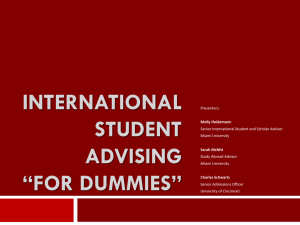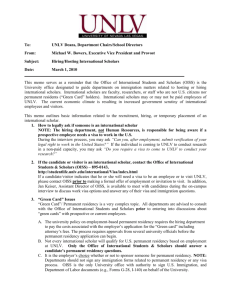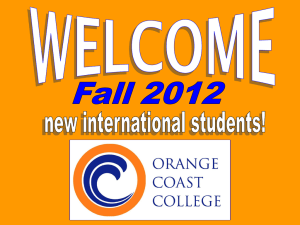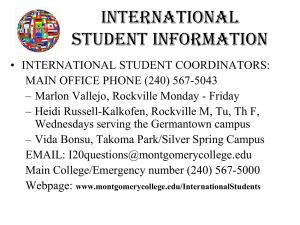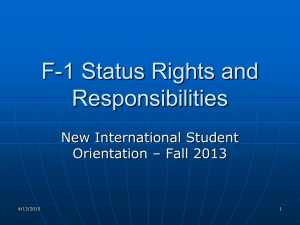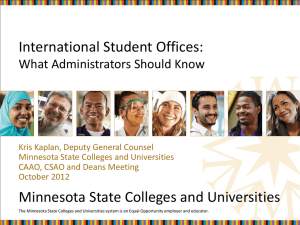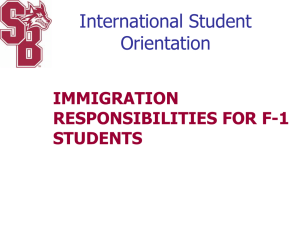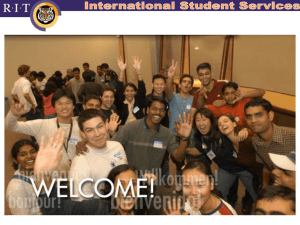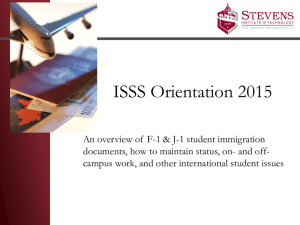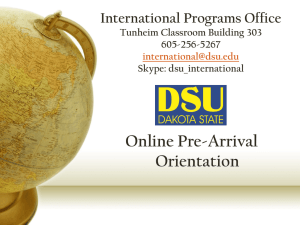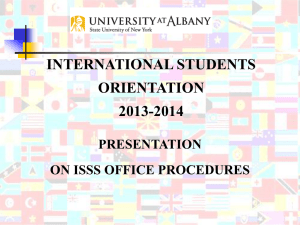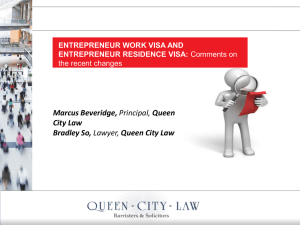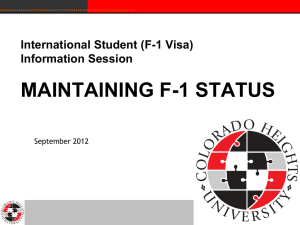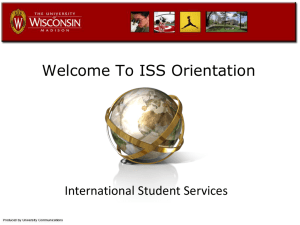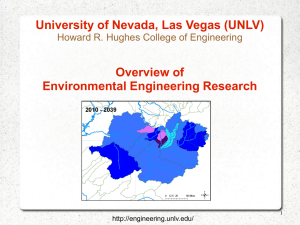International Admissions-OISS
advertisement
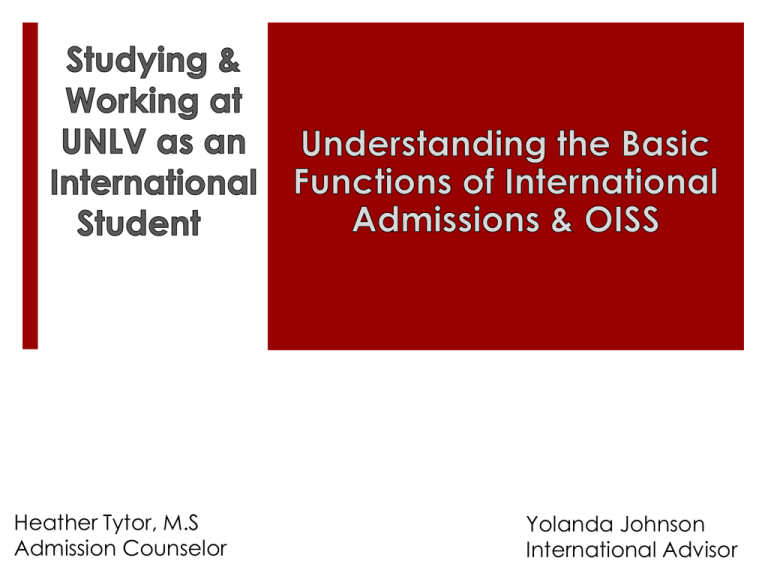
Heather Tytor, M.S Admission Counselor Yolanda Johnson International Advisor Identifying an international student A student who is not a U.S. citizen nor a U.S. permanent resident (green card holder) who is using an F-1 student visa to study in the U.S. Other common types of visas: F2 B1 H1B J Immigration 101 Two different government departments are involved when someone wants to come to the U.S. Department of State (Embassies overseas) Responsible for issuing visas Department of Homeland Security (former INS) Decide whether to allow you to enter and how long you can stay for any particular visit. Immigration 101 Immigration 101 Once student has entered the US, the visa stamp in the passport is no longer important. Student can stay in the US as long as the visa status is valideven if the visa stamp expires. International Admissions The application is the same for both domestic and international students. The visa question will determine whether a student is coded as an international student once it is submitted. International Admissions Determining the status of an application The first evaluation status an application is in is known as ‘IP’ or In Progress. The application is in this stage until the initial checklist is complete. In order for an international applicant to complete this stage he/she must have submitted the following: Official transcripts-High School, College, and/or Universities attended Certified Evaluation-NACES evaluation of any/all non-US schools attended Proof of English proficiency. International Admissions Proof of English Proficiency Applicants whose native language is not English must provide official TOEFL, IELTS, Michigan Exam test scores to the Office of Admissions. Student’s who do not have proof of English proficiency may choose ‘ESL’ as their major on the application. In this case proof of English proficiency is waived. Transfer students (students attending a US college or university) may use completed course work in Freshman Composition equivalent to UNLV’s English 101 (grade of C or better) as proof of English proficiency. International Admissions Proof of English Proficiency We require the following scores for general admission into UNLV: TOEFL: score of 61 iBT version IELTS: overall band of 6 with no band below 5.5 Michigan Exam (offered by UNLV’s English Language Center): score of 76 Hotel College Requirements: TOEFL: total score of 80 with 20 on the writing section IELTS: overall band of 6.5 with a 6.0 on the writing section Michigan Exam: total score of 81 with a 40 on the writing section SAT: 510 (CREAD) ACT: 21(ENGL) International Admissions Foreign credential evaluation Students who have completed coursework at a non-U.S. high school, college, or university are required to have their documents evaluated Course by course with GPA calculation Translation necessary if transcripts are not in English Must be completed through a NACES (www.naces.org) member Most commonly used companies: Educational Credential Evaluators (ECE) Josef Silny World Education Services (WES) I-20 An I-20 is a Department of Homeland Security (DHS) form that the school gives to an international student: A student overseas needs the I-20 to apply for the F-1 student visa at the U.S. Embassy A student already in the U.S. in F-1 visa status must keep his/her I-20 valid and accurate (right school, right major) so student will need to transfer I-20 to UNLV I-20s have a SEVIS number that follows the student as they transfer schools in the US. I-20 I-20 page 2 I-20 page 3 I-20 Requirements to get an I20: Be admitted to a full-time academic degree program (Bachelor’s, Master’s, PhD) which is taught in-class. UNLV cannot issue an I-20 for a non-degree program, nor for a certificate program, nor for a program that is taught mostly on-line Demonstrate that the student has ready access to the funding necessary for paying full-time tuition and living expenses for at least one year. http://www.unlv.edu/admissions/confidential-financial-certification Undergraduates: $38, 528 (2014-2015) Graduates: $40,122 (2014-2015) Obtaining the F-1 Visa After receiving the acceptance letter and I20 from UNLV: Pay the SEVIS fee at www.fmjfee.com Will be required to show receipt at the visa interview Contact the local US Consulate/Embassy to schedule interview Bring the following documents to the visa interview: Letter of admission to UNLV UNLV signed I20 SEVIS fee receipt Valid passport Financial support documents About the Office of International Students and Scholars (OISS)? OISS: Answer students immigration questions. Assist with student’s transitions from their home country to the U.S. Assist with cultural and personal needs. Respond to questions and concerns from the various departments. Report to Department of Homeland Security(DHS) through the SEVIS internet database system. Provide Immigration orientation and various workshops to incoming and current students. F-1 -Vs-J-1 Visa SEVIS Monitors: Department of Homeland Security manages the F visa classification F-2 Visa is the dependent of the F-1 M Visa (UNLV do not enroll) Department of State manages Exchange Visitor Programs, nonimmigrant exchange visitors in the J visa classification Professor or and Research Scholar Short-Term Scholar- Visiting scholars Intern Maintaining F-1 Student Status Students Should: Not enter the US no more than 30 days from the date the program of study begins. Immediately contact the DSO when they arrive in the US and no later than the program start date on the I-20. Attend and pass all courses Complete their program of study before the end date on the I-20. Enroll in and complete all course of study each semester 12 credits undergraduate 9 credits graduate One 3 credit online course counts towards full-time enrollment Not withdraw from courses without speaking with an international student advisor. Not work without prior authorization Maintaining F-1 Student Status Student have a 60 day grace period after they complete their program of study. After Program completion student should prepare to: transfer to another school Change educational level Change visa status Return home Immigration 102 I-20 USCIS PASSPORT SEVIS VISA F-1 STATUS I-94 D/S (I-94) DSO Customs and Border Patrol (CBP) Travel Signature DHS U.S Immigration and Customs Enforcement(ICE) Employment and Training Training Opportunities: Curricular Practical Training(internship) CPT is authorized by DHS through SEVIS Has to be an integral part of an established curriculum and related to your major Must request DSO authorization Optional Practical Training OPT can be pre- completion and post-completion graduation OPT is authorized by USCIS OPT is approved for 12 months and must be related to the students' major On-Campus Employment Students can begin on-campus employment 30 days from the date classes begin, they must apply for a work permit through OISS. Note: Students should not work under any circumstances until they speak with their international student advisor. Hiring an International Student to Work on Campus Student Must: Apply for the work permit The student should NEVER begin work until you receive a copy of the permit The work permit is an email sent from OISS to the students REBELMAIL Get the Social Security letter signed (if necessary) Some students may already have a card, they will not need to complete this step Print a copy of the I-94 arrival record Part 1 of the I-9 Hiring an International Student to Work on Campus You Must: Fill out and Sign the Social Security letter printed on your letterhead Only necessary if the student does not already have a card Verify the student has required documents I-20 Passport I-94 On campus work authorization letter issued from OISS Things to remember: F-1 students are only eligible to work on campus 20 hours (total) per week during the Fall and Spring semester. If the student has multiple authorizations (on campus, GA, or CPT) the TOTAL hours per week for on campus work cannot exceed 20 hours. During the Summer and Winter vacation period F-1 students are eligible to work up to 40 hours. Students must request a new On Campus Work Authorization Letter each semester. A new I-9 or section 3 will need to be filled out again whenever a new letter is issued. Questions about the I-9 can be directed to Human Resources or consult the M-274 Handbook for Employers Questions about the requirements for F-1 students can be directed to OISS Questions ? International Admissions (Office of Admissions) Building SSC-B Phone: 702-774-8003 Fax: 702-895-4046 Email: internationaladmissions@unlv.edu Office of International Students and Scholars (OISS) Enrollment Services Center – Building SSC-C Phone: 702-774-6477 Fax: 702-895-0155 Email: OISS@unlv.edu
